The Beautiful Malady of Collecting: Interview with Ruvim Braude
Published in: 15. The Heart of Things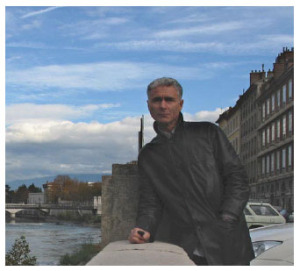
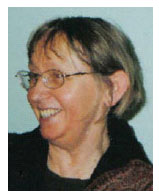
Irina Rapoport
You draw, you draw,
it’ll be to your credit.
— Bulat Okudzhava
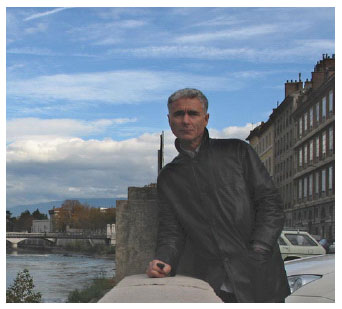
Ruvim Braude
San Francisco, Monterey Boulevard. I approach a house that sooner recalls a miniature castle. It stands on a hill overlooking the ocean, today as still as blue glass. Only white sailboats in the distance enliven its placid smoothness. An improbable peace!
The door is opened by the house’s master—an energetic, graying, highly charming man. It was he, Ruvim Braude, who gathered in the house (later helped by his wife Inna) a unique collection of the paintings and drawings of Leningrad artists of the second half of the 20th century. Entering here, you immediately feel the atmosphere of the intense life of Leningrad, in which the artists lived and struggled, defending their right to express themselves in art.
The fight to establish an independent art had begun in Leningrad by the 1950s and reached a peak in the 1970s. Its best-known events proved to be the famous exhibits at the I. Gaz Palace of Culture in 1974 and at the Nevsky Palace of Culture in 1975, held in response to the so-called “bulldozer” exhibit in Moscow in 1974. The Leningrad artists called their movement “Gaza-Nevsky culture” or Gazanevshchina. As a result of this movement, there emerged a “Fellowship of Experimental Exhibitions” — TEV.
By the 1980s, due to pressure from the authorities, many of the participants in Gazanevshchina were forced to emigrate. The rest, along with artists of the younger generation, organized as TEII, “Fellowship of Experimental Fine Arts”. TEII formed the basis for a third formation — the Fellowship “Free Culture” along with the art center “Pushkinskaya-10”.
“Pushkinskaya-10”, thanks to the noble and tireless work of leading artists Sergei Kovalsky and Yevgeny Orlov, has turned into a major cultural center, now known in many countries throughout the world. The center has expanded its activies to other areas of culture and has also created a permanent Museum of Non-Conformist Art.
At “Pushkinskaya-10”, great care is shown to the cultural heritage of the Gazanevshchina artists. In 2004 in Petersburg, at the Central Exhibition Hall “Manege”, a “Festival of Independent Art” took place, dedicated to the thirtieth anniversary of the exhibit at the Gaz Palace of Culture. The organizers did a tremendous job, gathering materials and showing the work of all the participants of Gazanevshchina and “Pushkinskaya-10”, connecting the past and the present of the non-conformist art of Leningrad-Petersburg.
Braude’s collection in San Francisco happens to be devoted mainly to Leningrad non-conformist artists. Assembled very thoughtfully, it presents artists of many different directions. No artist, no work is here by chance. Each work bears the imprint of its author’s identity and has its own place in the collection. Rarely can one see such a clearly focused private collection.
IRINA RAPOPORT (IR) — Ruvim, tell me, please, what caused you to start collecting? Fine art probably wasn’t a central interest in your family. Your grandfather was the chief rabbi of Leningrad.
RUVIM BRAUDE (RB) — The turning point and the beginning of my interest — no, passion for art — was the exhibit in 1975 at the Nevsky Palace of Culture, to which a friend happened to take me. This had an aesthetic, moral, political impact that qualitatively changed by life. I was also stunned by viewers’ interest in this exhibit: such a conscious, collective interest in art. Remember the unprecedented lines for the exhibit? I began to dream that one day I could have one or two of those works. Unfortunately, at that time I knew nothing about the apartment exhibits of the 1970s.
IR — When did you start thinking about your own collection?
RB — In 1981 I happened to visit an emigrant household in Long Island where all the walls were hung with works by non-conformist artists. This immediately awakened assocations in my memory and a thought crossed my mind about a potential chance for collecting. That same year, I learned by chance about an exhibit of Y.Abezgauz at a synagogue in New Jersey. I remember him from the Nevsky exhibit, and with my meager funds acquired his graphic work “Again a Pogrom. What’s to be Done?”
IR — So a chain of “coincidences” led you to the idea of collecting. What was the first painting in your collection?
RB — “Sabbath”, by Alexander Manusov (Ill. 1). I still have a sense of awe when I look at it.
IR — A beautiful start! Sasha, whose life ended prematurely, was a brilliant colorist, as this work shows. He has a very serious series on the theme of the Old Testament and the Holocaust.
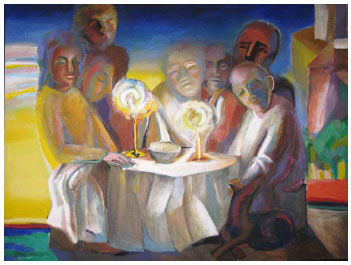
- A. Manusov, Sabbath
Yes, the art of Gazanevshchina truly left a deep trace in your mind. The well-chosen works by its participants, as well as by members of the “ALEF” group that emerged from it, have made the collection very focused.
RB — But I didn’t limit myself, it just happened. And those weren’t the only “coincidences”. An aquaintance staying a few days in San Francisco met (again by chance!), in Chinatown, Alek Rapoport and you. I remembered Alek’s art from Leningrad and just leaped at the opportunity to get to know him personally.
The late I.V. connected me with Zhenya Ukhnalyov, asking me to help him sort out documents related to his stay as a guest in San Francisco. R.S., the widow of Sasha Manusov, acquainted me with Sasha Gurevich, and this meeting was providential for both of us.
IR — You’re a guardian angel for Gurevich’s art. You’ve done everything a sponsor can do for an artist: assembled a large collection of his works, organized several exhibits at your home, presenting his art to many viewers, part of whom in turn started getting involved in collecting. You also systematized his own collection and organized the release of an outstanding album… You know, as Matisse’s son said: “If it hadn’t been a Shchukin, there wouldn’t have been a Matisse.” These words don’t downplay the significance of the artist’s creativity, but express the well-earned thanks due to the sponsor.
The painting reproduced here (Ill. 2) is very typical for Sasha. In the words of the wonderful art historian B.M. Bernshtein, the art of the past “weighs on an artist like the atmospheric column.” Most of Gurevich’s scenes and compositions suggest old painting, much as this one relates to a painting by the 17th century French artist G. de la Tours. The scene has an interesting detail: beside the sitting musician, who has Gurevich’s own face, rests a handful of small change. It’s a symbol of the sad lot of most artists in all times.
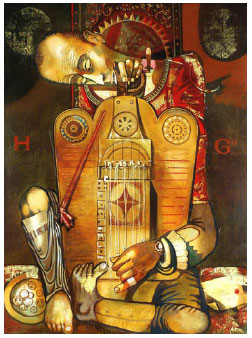
- A. Gurevich, Hurdy-Gurdy Player
RB — And here is my favorite artist from Gazanevshchina and the ALEF group — Alek Rapoport.
IR — Alek is my favorite artist, too. “The soul of my soul,” with whom we were connected in 35 years of love. Probably in the passion, the intensity, the seeking after truth, the religious doubts, in which he lived and worked, can be found the reason for his early death while at work in his workshop in San Francisco. As B.M. Bernshtein pointed out in studying the cycle “Angel and Prophet”, it’s even hard to understood what the artist expected, releasing his progeny into this world: “In the veins of the outwardly calm and wise artist streamed the blood of Biblical prophets, visionaries and heralds of truth.” M.Lemkhin compared Alek with Atlas, who “didn’t even think of tossing the weight of great traditions from his shoulders — art for him was primarily responsibility.”
You have representations of all the genres Alek worked in: Biblical, “Images of San Francisco,” self-portraits, still-lives (Ill. 3). Here is also “Self-Portrait” from the 1950s, which Alek did while still quite young, and soldier drawings from the period when he served in the army in Birobidzhan. You even have his “Composition with a Kwakintle Mask” — a result of Alek’s brief study of the cultural heritage of American Indians.
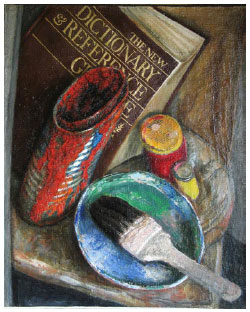
- A. Rapoport, Still-Life with Dictionary
RB — I know Alek admired the work of Sasha Arefyev. I greatly value this drawing of his, the only one in my collection (Ill. 4).
IR — Yes, it is rare. Sasha Arefyev was one of the most significant figures of Leningrad non-conformism. He was a remarkable artist and a born fighter. By the 1950s he had already organized the “Order of Mendicant Painters”. The subject of the drawing in your collection is very typical. The theme of the “victim’s suffering and the tormentor’s delight” runs through all his work.
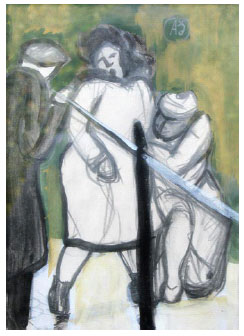
- A. Arefyev, Lady and Two Hooligans
RB — And here’s another artist from Gazanevshchina and the “ALEF” group — Anatoly Basin, quite a different nature: sad, harmonious, intimate (Ill. 5). I recall that Alek appreciated his work. Did they have different teachers?
IR — Yes. Basin belonged to the “Sidlin school”, well-known in the 1950s and ’60s. O.A. Sidlin (1909-1972) taught at Leningrad art studios and had an enormous impact on a large group of artists, many of whom joined the non-conformist movement. Basin is a typical “Sidlinite”. The teacher’s idea was to concentrate on the painting process itself (not on depicting emotions, literary scenes, psychology and so on). Sidlin taught to convey impressions of the world only as organized blotches of color. Before his death, he destroyed all his works, because he thought only the creative process itself was important, not its result. Sidlin’s remaining students still pronounce his name with breathy reverence.
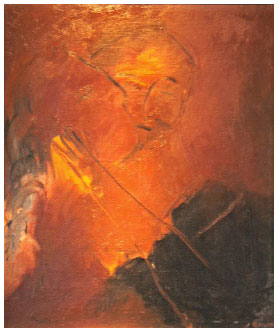
- A. Basin, Two
One of Alek’s fellow students in N.P. Akimov’s class at the Leningrad Institute of theater, music and cinematography, as well as his friend, was Misha Kulakov. Living in Italy, he didn’t directly take part in the Leningrad non-conformist movement, but was also a non-conformist by nature, as well as in the manner of his work. He was one of the first among his peers to start studying the work of Jackson Pollock and to make his own abstract compositions. Unlike most emasculated American abstraction, his works are spiritual and carry a charge of unorthodox religiosity (Ill. 6).
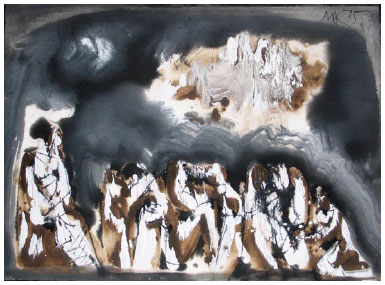
- M. Kulakov, Composition
You have many works by Yevgeny Ukhnalyov. Alek called him an “honest artist.” Among the works of his that I know, “Boxcar” stands out (Ill. 7). It has so much symbolism, which I don’t always understand. Tell me about it, please.
RB — “Boxcar” is an extremely interesting triptych, which consists of three separate parts. Zhenya himself named this work with a line from a song by Galich, “Kadish”: “And somewhere on the rails, on the rails, on the rails — wheels, wheels, wheels, wheels…” An old, fire-scorched boxcar, depicted in three parts that reflect three different periods of the history of the 20th century, with the horrors of revolution and civil worn; the Second World War and the Holocaust; the Stalinist repressions.
On the left side of the boxcar is a symbol of the outgoing government in the emblem of the czarist empire—a double-headed eagle—and sloppily written fragments of revolutionary slogans: “All power…”, “Give…” and so on. In the distance is a dark smoky glow.
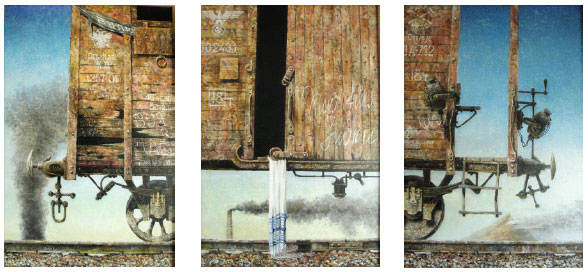
- Y. Ukhnalyov, Boxcar (triptych)
On the middle part of the boxcar’s wall is a Nazi swastika, fragments of inscriptions in German, including a sprawling “only for Jews, 1944”. The door is open, the boxcar is empty, only over its edge hangs one end of a prayer shawl. In the distance is a row of gloomy camp buildings and the smoking chimney of a crematorium.
On the right side is the stamp of the October Railroad, an indication of the destination, “Rechlag”, 1948 and the camp number that was assigned to the 18-year-old inmate Yevgeny Ukhnalyov. In the distance is the “smoking hill of Vorkuta”.
IR — Thank you, Ruvim. I think it’s Ukhnalyov’s most significant work, and I’m glad it’s in your collection.
Michael Iofin came to the exhibit at the Gaz Palace of Culture as a 14-year-old boy. It was then, he said, that he realized that besides “Soviet” art there was also “different and real” art. In his subsequent work, Misha preserved the best traditions of “dissident” artists and became an original and mature artist. His typical topics deal with the artists of the past, as well as the theme of the theatrical and dramatic carnival of Petersburg-San Francisco. He pays tribute to Petersburg in almost all his works. But the painting in your collection, Ruvim, focuses completely on the city’s image and on conveying its hidden spirit. I like this work very much — “Pushkin over Petersburg” (Ill. 8).
The northern, pale, quiet dusk. The stern geometry of five horizontal lines: the embossed line of the black lattice of iron railings powdered with snow; the line of the single-toned, motionless surface of the Neva; the clear line of the opposite shore; the unbroken line of slightly tinted buildings, the monotone line of their upper boundary, enlived by the verticals of the spire domes, chimneys. And over this landscape — the horizontally soaring figure of A.S. Pushkin, overshadowing and personifying Petersburg, the city mirage, frozen in its perfect and eternal harmony.
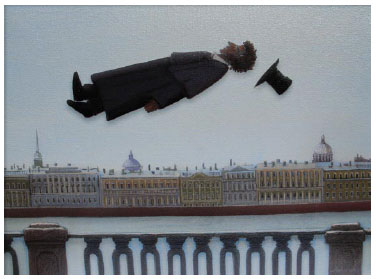
- M. Yofin, Pushkin over Petersburg
It also seems remarkable to me how precisely the artist captured the idea of Peter the Great, the principle of of strict regulation in constructing the city — exemplary, proper, regular, geometrically calibrated. This work is so close to my heart!
RB — Several other artists in my collection have ties with Gazanevshcina — V. Weiderman, Y. Abezgauz, S. Ostrovsky. And with “Pushkinskaya-10” — V. Gerasimenko, Y. Tikotsky, B. Borsch.
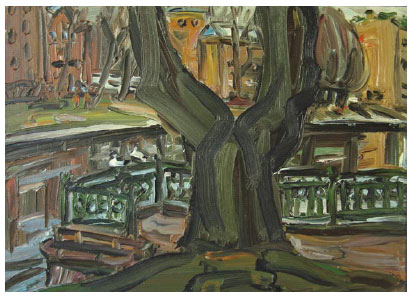
- B. Borsch, Petersburg Landscape
IR — Boris Borsch may be one of Petersburg’s best contemporary landscape artists (Ill. 9). But this graphic sheet by Y. Tikotsky, “Fragment” (Ill. 10), strikes me as unusual. I don’t know his work very well, but it seems to me that this drawing, describing the details of routine life in a “mestechko” townlet, falls outside of the main line of his work with its Semitic theme and spirit.
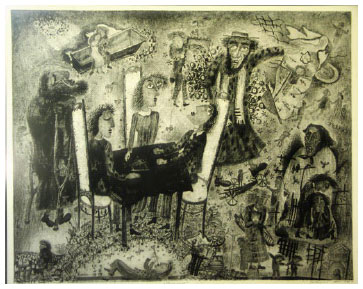
- Y. Tykotsky, Fragment
Yakov Feldman. Ruvim, I’ve never seen his work before, and I like them very much. Who is he?
RB — He’s a young artist, born in Vitebsk, and now living in Jerusalem. It’s interesting that his grandmother was a niece of M. Chagal.
IR — His “Adam and Eve” (Ill. 11) is painted skillfully and its technique reminds me of the work of the old masters — on a board, dark and rich paint on the surface, the use of glaze. Yet the traditional Biblical subject is brought nearer to modernity with two kitsch details — Eve, instead of a fig leaf, is shielded by an image of scissors, and Adam, by a spoon. It’s a wonderful acquisition, and a perfect fit for your collection.
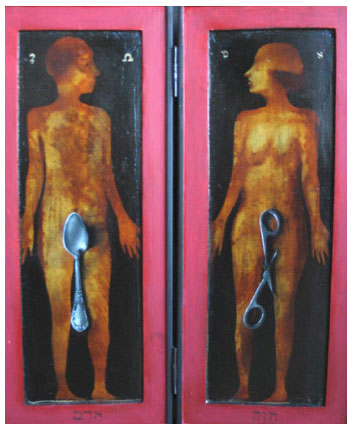
- Y. Feldman, Adam and Eve
Ruvim, in what direction will you continue — increasing the number of artists the collection already represents, or will you emphasize Jewish artists, or contemporary non-conformist art from Petersburg?
RB — I’m still collecting. Fortunately, my wife Inna supports me. She understands that collecting for me isn’t a hobby but a passion, born during the rise of non-conformist art. It’s a unique phenomenon in the history of development of art, a entire movement arising as a consequence of unprecedented violence against art. The bitter irony is that art was born not in spite of but because of persecution.
I don’t approach collecting for a purely aesthetic position — this I like, that, no. I don’t approach it with a commercial outlook, either — selling the next day what goes up in price. What’s important to me is art’s combination of historical, political, psychological, aesthetic significance. I think I’ll expand my collection of artists I already have. They’re going through transformations on their creative path, and I’ll go with them, on the same road. I also want to expand my collection by acquiring art by contemporary artists connected with “Pushkinskaya-10”.
IR — How many works are included in your collection? What part of them are you able to display on the walls of your home?
RB — About a hundred paintings, plus drawings and some sculpture, and probably a third of that is on display.
IR — Do you acquire works, as did your famous predecessory P.M. Tretyakov, while visiting the workshops of unknown artists?
RB — I guess so.
IR — Are artists generous with gifts?
RB — Yes, they’re generous. The thing is, some of my favorite artists also become favorite friends, with friendships lasting many years. A gift is always nice, but one has to keep in mind that an artist’s work is also his way of making a living.
IR — I’m delighted that your collection doesn’t included any emasculated Moscow “dip-art” — “art for diplomats”, which almost no Russian collection or gallery is without. It worked out, in the 1960s and ’70s, that namely diplomats in Moscow, often with no understanding of art, became the main judges, the final authority deciding whom to promote and whom to ignore. In this way they tossed out worthy artists and advertised unworthy ones, and thus did great harm to the objective assessment of art in general.
A provocative question — do you have, for example, Oscar Rabin?
RB (in mock embarassment, lowering his eyes) — Yes, even two (Ill. 12).
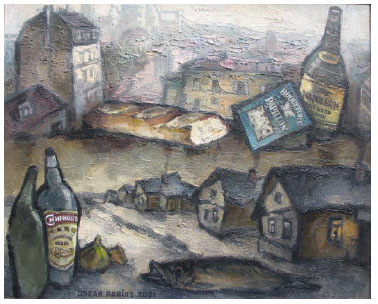
- O. Rabin, Landscape with a Roll
IR — Yes, I understand. Rabin is a purely Moscow phenomenon with antecedents in the Wanderers. Unattractive paintings, monotonous subjects: vodka and herring; bread and rolls; shreds of newspaper or something else; the crooked cottages of the impoverished provinces; poor, hopeless Russia… But of course, his role as a mastermind and organizer of the non-conformist movement in Moscow is beyond question.
RB — From what I know Moscow art, I can’t relate to it as well, I don’t feel as close to it. But Petersburg’s is my own, personal art, like family.
IR — So, closing our brief conversation, I’d like to note that Ruvim Braude is a very serious collector with his own firm concepts. His standard is his own, straightforward assessment of a painting, without checking on others’ opinion. It’s very important that he loves and values artists’ own personalities, as well as their creations.
The collecting of contemporary art is an occasion for special respect, in that the collector doesn’t know what commercial category the artist will end up in. The collector makes a personal investment in art whose eventual fate is impossible to know in advance.
Sometimes modern private collections grow to form large parts of museums, as happened with the collection of professor Norton Dodge, which became the most complete gathering of Russian non-conformist art, as part of the Zimmerli Art Museum in New Jersey. Who knows what the current collection of Ruvim and Inna Braude may turn into?
In conclusion, I’d like to express heartfelt recognition to both of them for their philanthropic work and to wish them never to be cured of the “beautiful malady of collecting.”
LIST OF ILLUSTRATIONS
Ill. 1
Alexander Manusov (1947-1990)
Sabbath, 1989
Oil on canvas
100 x 120 cm
Ill. 2
Alexander Gurevich (b. 1944)
Hurdy-Gurdy Player, 2003
Oil on canvas
127 x 94 cm
Ill. 3
Alek Rapoport (1933-1997)
Still-Life with Dictionary, 1982-1997
Mixed media on canvas
91.5 x 71 cm
Ill. 4
Alexander Arefyev (1931-1978)
Lady and Two Hooligans, 1955
Gouache, pencil on paper
20 x 15 cm
Ill. 5
Anatoly Basin (b. 1936)
Two, 1989
Oil on canvas
61 x 51 cm
Ill. 6
Mikhail Kulakov (b. 1933)
Composition, 1975
Mixed media
56 x 76 cm
Ill. 7
Yevgeny Ukhnalyov (b. 1931)
Boxcar (triptych), 2001
Oil on canvas
91.5 x 183 cm (three parts together)
Ill. 8
Michael Yofin (b. 1959)
Pushkin over Petersburg, 2003
Oil on canvas
23 x 30.5 cm
Ill. 9
Boris Borsch (b. 1948)
Petersburg Landscape, 1989
Oil on canvas
53 x 66 cm
Ill. 10
Yevgeny Tykotsky (b. 1941)
Fragment, 1975
Dry quill, paper
Ill. 11
Yakov Feldman (b. 1969)
Adam and Eve, 2002
Oil on board (diptych)
52 x 21.2 cm (each part)
Ill. 12
Oscar Rabin (b. 1928)
Landscape with a Roll, 2001
Oil on canvas
61 x 76 cm

Speak Your Mind